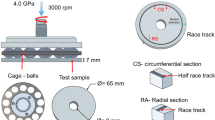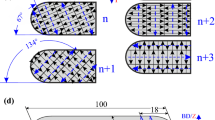Abstract
The fracture characteristics of 20% cold worked Type 316 stainless steel irradiated at 377–400°C to a fluence of 11 × 1022n/cm2 (E > 0.1 MeV) were evaluated based on SEM fractography andJ-integral fracture toughness data. Compact tension specimens were tested at temperatures ranging from 232 to 649°C. A significant reduction in fracture toughness after irradiation was observed, which correlated well with the fracture morphology of the material. It was found that irradiation induces a shift in the transgranular-intergranular fracture transition temperature to a lower temperature. Irradiated specimens exhibited transgranular channel fracture from 232 to 538°C and intergranular fracture at 649°C, while unirradiated specimens failed in a transgranular ductile fracture mode up to 549°C. SEM fractographs revealed plate-like, faceted fracture surfaces of irradiated specimens. The faceted fracture appearance is associated with flow localization and dislocation channeling, phenomena that undoubtedly contribute to the decrease in fracture toughness. The possibility that ordered γ′-phase particles are partially responsible for the reduced toughness as well as for irradiation hardening is discussed.
Résumé
En utilisant la fractographie SEM et des données de ténacité à la rupture basées sur l'intégrale J, on a évalue les caractéristiques à la rupture d'un acier inoxydable type 316 écroui de 20% et irradié à 377–400°C sous un flux intégré de 11.1022 n/cm2 (c > 0.1 MeV).
Des éprouvettes de traction compactes ont été soumises à essai à des températures comprises entre 232 et 649°C. On a observé une réduction significative de la ténacité à la rupture due à l'irradiation, ceci étant confirmé par la morphologie de la rupture. L'irradiation provoque un glissement de la température de transition de rupture intergranulaire-transgranulaire vers une température plus basse. Des échantillons irradiés ont fait état d'une rupture transgranulaire entre 232 et 530°C et d'une rupture intergranulaire à 649°C.
Par contre, des échantillons non irradiés se sont rompus de manière transgranulaire jusqu'à 649°C. Les microfractographies révèlent, sur les éprouvettes irradiées, des surfaces de rupture à facettes, qui sont associées à une localisation de l'écoulement plastique et à une concentration des dislocations, phénomène qui, sans nul doute, contribue à réduire la ténacité à la rupture. On discute de la possibilité d'une responsabilité partielle de particules de phase y' dans la réduction de la ténacité et dans le durcissement dus à l'irradiation.
Similar content being viewed by others
References
G.T. Hahn and A.R. Rosenfield,Metallurgical Transactions A 9A (1975) 653–668.
W.G. Wolfer and R.H. Jones,Journal of Nuclear Materials 104 (1982) 1305–1314.
F.H. Huang and R.L. Fish,Effects of Radiation on Materials, ASTM STP 782, Philadelphia (1982) 701–719.
D.R. Muzyka, inThe Superalloys, ed. C.T. Sims and W.C. Hagel, John Wiley and Sons, New York (1972) 113–143.
I.G. Greenfield and H.G.F. Wilsdorf,Journal of Applied Physics 32 (1961) 827–839.
R.P. Tucker, M.S. Wechsler and S.M. Ohr,Journal of Applied Physics 40 (1969) 400–408.
F.A. Smidt, Jr. and B. Mastel,Philosophical Magazine 20 (1969) 651–656.
F.H. Huang and G.L. Wire, inProceedings of International Conference on Dimensional Stability and Mechanical Behavior of Irradiated Metals and Alloys, British Nuclear Energy Society (London) (1983) 135–138.
F.H. Huang and G.L. Wire,Journal of Engineering Materials and Technology 101 (1978) 403–406.
P.C. Paris, H. Tada, A. Zahoor and H. Ernst, inElastic-Plastic Fracture, ASTM STP 668, Philadelphia (1979) 5–36.
J. Dufresne, B. Henry and H. Larsson, inEffects of Radiation on Structural Materials, ASTM STP 683, Philadelphia (1979) 511–528.
E.A. Little, inProceedings of International Conference on Dimensional Stability and Mechanical Behavior of Irradiated Metals and Alloys, British Nuclear Energy Society (London) (1983).
W.J.S. Yang, H.R. Brager and F.A. Garner, inProceedings of A Symposium on Phase Stability During Irradiation, The Metallurgical Society of AIMS (1980) 257–269.
R.L. Fish, J.L. Straalsund, C.W. Hunter and J.J. Holmes, inEffects of Radiation on Substructural and Mechanical Properties, ASTM STP 529, Philadelphia (1973) 149–164.
G.T. Hahn and A.R. Rosenfield, inApplications Related Phenomena in Titanium,, ASTM STP 432, Philadelphia (1967) 5–32.
B. Weiss and R. Stickler,Metallurgical Transactions 3 (1972) 851–866.
J.R. Rice and M.A. Johnson, inInelastic Behavior of Solids, ed. M.F. Kanninen et al., McGraw-Hill, New York (1970) 641–670.
G. Green and J.F. Knott, ASME Conference on Micromechanical Modeling of Flow and Fracture, Troy, New York, Paper No. 75-Mat-10 (1975).
E. Smith, T.S. Cook, and C.A. Rau, inFracture 1, ICF4, Waterloo, Canada (1977) 215–226.
C.A. Berg, inInelastic Behavior of Solids, ed. M.F. Kanninen et al., McGraw-Hill, New York (1970) 171–210.
W.J. Mills,Metallurgical Transactions 11A (1980) 1039–1047.
A.J.E. Foremon and J.V. Sharp,Philosophical Magazine 19 (1969) 931–937.
H.R. Brager and F.A. Garner,Journal of Nuclear Materials 73 (1978) 9–19.
G.D. Johnson, F.A. Garner, H.R. Brager and R.L. Fish, inEffects of Radiation on Materials, ASTM STP 725, Philadelphia (1981) 393–412.
W.D. Nix, D.K. Matlock, and R.J. Dimelfi,Acta Metallurgica 25 (1977) 495–503.
J.A. Williams,Philosophical Magazine 20 (1969) 635–639.
C.Y. Li, F.V. Ellis and F.H. Huang, inAlloy and Microstructural Design, ed. J.K. Tien and G.S. Ansell, Academic Press, New York, (1976) 403–424.
E.E. Bloom and J.R. Weir, Jr.,Nuclear Technology 16 (1972) 45–54.
Author information
Authors and Affiliations
Rights and permissions
About this article
Cite this article
Huang, F.H. The fracture characterization of highly irradiated Type 316 stainless steel. Int J Fract 25, 181–193 (1984). https://doi.org/10.1007/BF01140836
Received:
Revised:
Issue Date:
DOI: https://doi.org/10.1007/BF01140836




